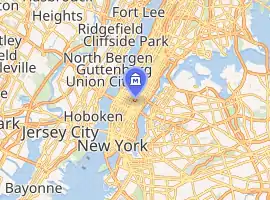Austrian Cultural Forum New York
The Austrian Cultural Forum New York is one of Austria’s two cultural representation offices in the United States; the other is in Washington, D.C. It is part of the worldwide network of Austrian Cultural Forums of the Austrian Federal Ministry for European and International Affairs.
 | |

| |
| Established | 1942 |
|---|---|
| Location | 11 East 52nd Street, Manhattan, New York, United States |
| Director | Christine Moser |
| Website | www.acfny.org |



History
The Austrian Cultural Forum New York was founded as the Austrian Institute in 1942 in New York City by Austrian immigrants to the United States for the purpose of preserving and disseminating Austrian culture. One of the leading figures of that time was émigré Irene Harand.
In 1963, it opened offices at its current location at 11 East 52nd Street in Manhattan, as the official cultural representation office of the Austrian federal government. In 2002, the institution, now called the Austrian Cultural Forum, moved into a new building at the same address. The Cultural Forum is a division of the Austrian consulate in New York.
Since October 2018, Austrian diplomat Michael Haider is the director of the Austrian Cultural Forum New York. His predecessors include Christine Moser, Andreas Stadler, Christoph Thun-Hohenstein, Wolfgang Waldner, Peter Marboe, Fritz Cocron, and Wilhelm Schlag.
Building
Architect Raimund Abraham was the winner among 226 submissions in a competition held in 1992 to choose a design for the ACFNY’s new building. Completed in 2002, the building is situated on a plot in Manhattan that is only 24.5 feet (7.5 m) wide[1] and 81 feet (25 m) deep.[2] It is considered as an architectural anomaly because despite its small footprint it is 24 stories and 275 feet (84 m) tall. The building’s facade is clad in glass and aluminum and gradually tapers to a narrow point as the building slants upwards. The structure is regarded as one of the most interesting architectural projects in recent New York history. It houses exhibition spaces, a theater, a library for books and audio recordings, offices, seminar and reception rooms, and apartments for the officers of the institution.
Activities
Since its founding, the ACFNY has served as a place for cultural exchange between Austrians and Americans and introduces Austrian artists at venues all over the USA. It is responsible for cultural and academic cooperation throughout the United States of America, with the exception of Washington D.C., which has its own cultural forum under the auspices of the Austrian Embassy. It organizes its own events and promotes collaborative efforts with various cultural institutions in the USA, with an emphasis on contemporary, artistic, sociopolitical, and academic subjects.
Exhibitions and events
In the ACFNY building, five floors are used as exhibition space for predominantly contemporary art, generally presented in the context of three major thematic exhibitions per year. Smaller, event-type installations take place in between.
Concerts and performances are presented either in the in-house auditorium or at various venues in New York. Outside performances are organized in cooperation with American partner institutions, and have included concerts at Carnegie Hall and Judson Memorial Church.
The ACFNY regularly screens films on Austrian subject matters or by Austrian filmmakers. Additional activities of the Austrian Cultural Forum New York include a variety of podium discussions, readings, and book presentations.
Library
The ACFNY Library is located on Levels 4 and 5 of the building and has a collection of more than 10,000 books relating to Austrian art and culture. The Library is currently being digitized; titles already catalogued can be searched online through the system of the Austrian Association of Libraries.
References
- ArchitectureWeek article from 2002
- "Arcspace interview". Archived from the original on May 16, 2008. Retrieved October 4, 2008.
External links
 Media related to Austrian Cultural Forum New York at Wikimedia Commons
Media related to Austrian Cultural Forum New York at Wikimedia Commons- Official website
